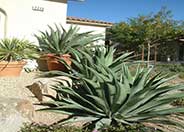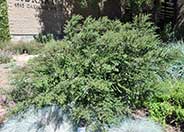
Common name:California Poppy, Golden Poppy
Botanical name:Eschscholzia californica
This small annual (sometimes acts as a perennial) plant will grow to less than 1' tall and has light, small blue green leaves with gold and orange flowers that bloom in spring and summer.

Common name:Smooth-edged Agave
Botanical name:Agave weberi
This is a striking medium-sized Agave that can grow to 5' tall by 6'-10' wide. This agave has very fine marginal teeth and is sometimes spineless. Supplemental summer watering can prevent yellowing from heat stress in the summer. These plants are also moderately cold hardy and tolerant of temperatures down to 12 degrees F. It is more refined looking than americana. It is native in central Eastern Mexico. It is one of the largest of the Agaves.

Common name:Dudleya
Botanical name:Dudleya cultivars
Dudleya cultivars are very numerous and they are typically low rosette shaped succulents. They are wonderful accent plants and work well in pots.
Maintenance Tips
Dudleya cultivars include a variety of low-growing, rosette-shaped succulents that are drought-tolerant and require very little maintenance. Most of these plants are native to the California and Mexican coasts, as well as the small adjacent islands. The majority of them prefer to be planted in full sun, along the coast, and in very well-drained soil. If they are planted in a garden with irrigation, it is often best to cut off the water to these plants in the summer as they are susceptible to root rot, especially when the weather is hot and humid. Almost all Dudleya will have old leaves that collect under the larger rosettes as they mature. These older leaves can be removed occasionally to keep the plant looking tidy.
Common name:Julia Phelps California Lilac
Botanical name:Ceanothus 'Julia Phelps'
Fast-growing and densely branched with small dark green leaves, this is a great bloomer showing a marvelous display of delicate, dark indigo blue flowers found in round clusters of 1". It is extremely drought tolerant, and must not be overwatered. It does best in well-drained soil with little to no summer water. It attracts hummingbirds, butterflies and beneficial insects.
Designer: Santa Barbara Botanic Garden
Photographer: GardenSoft
Physical weed control, including mulching, or hand removal protects the watershed from harmful chemicals.
Mulching and adding compost to soil can minimize evaporation and help soil absorb and store water.
Remove irrigation water and fertilizer from areas where you don't want weeds to grow.